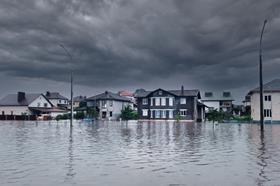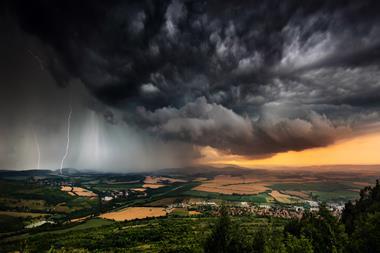Brokers that can help businesses with “training, monitoring and being ready” ahead of potential flood damage can ensure their commercial clients have a “massive differentiator”
Last year saw record rainfall and catastrophic flooding across the globe as extreme weather events continue to become more commonplace.
For example, the World Meteorological Organisation reported in October 2021 that western Germany and eastern Belgium received 100mm to 150 mm on 14 and 15 July over already saturated ground, causing flooding and landslides that led to more than 200 deaths. The highest daily rainfall was 162.4 mm at Wipperfürth-Gardenau.
The Swiss Re Institute additionally recorded in December 2021 that extreme weather events last year – including a deep winter freeze, floods, severe thunderstorms, heatwaves and a major hurricane – resulted in annual insured losses from natural catastrophes reaching $105bn (£77.4bn), the research firm’s fourth highest estimate since 1970.

November 2021 saw Storm Arwen cause a million power outages in the UK, with economic and insured losses from the event expected to reach into the tens of millions of pounds, according to an Impact Forecasting report published in December 2021.
A report on the UK’s climate risk, published by independent statutory body the Climate Change Committee in June 2021, recognised that the country’s climate is getting warmer and wetter.
So, the UK will subsequently face increasing rainfall intensity and continued sea level rises, while at the same time, more homes will inevitably be built on flood plains. As climate change exacerbates UK flood events, this may mean that some properties, or businesses, become uninsurable.
However, according to Joss Matthewman, director of climate change, product management and strategy at Risk Management Solutions (RMS), the situation is not clear cut.
He said: “The effect of climate change on UK flooding is currently a mixed picture.
“There are lots of different components of the climate system and while we can have some confidence on climate change globally, for instance that there may be more precipitable water because the atmosphere is warmer, that doesn’t necessarily mean that there will be more rain in the UK.
“Looking into the future, it is a little bit clearer - although there is no data to measure and capture, so we are reliant on projections from climate models.
“We can see that there are signals that emerge from climate change in the UK. These vary on where in the UK you are and which season we’re looking at. There are indications that overall, we’re looking at an increase in precipitation in the UK under a changing climate.
“The insurance industry has a history of innovation. We know that risks have emerged over time and that the industry has been able to innovate and bring solutions to tackle these.”
Spreading the cost
Despite the changing climate, UK homes will continue to be insurable for the foreseeable future.
This is because joint government and industry reinsurance scheme Flood Re provides a mechanism to ensure flood cover is available for the vast majority of homes – this protection is set to remain in place until at least 2039.
Between now and then, Flood Re - on behalf of its members - has an objective to increase individual flood resilience, particularly for those in high flood risk areas.
Nick Kitchen, personal lines underwriting director at insurer RSA, said: “Severity varies depending on the type of event. For example, flash flooding from surface water tends to be less expensive than river flooding, where water may be present in a property for several days.
“Flood Re has played an important role in ensuring that the vast majority of consumers can continue to access home insurance, despite the increasing frequency of flood events in recent years.
“Flood Re’s annual report stated that 96% of households at risk of flooding can now get affordable quotes from five or more insurance providers, without additional terms or conditions applied.

“However, we also need to be mindful that Flood Re is funded via a levy, which means that the costs are ultimately spread across all customers across the market.”
Kitchen added that it is imperative that the government continues to invest in flood defences. It should also stop granting planning permission and building on flood plains, as well as ensure that drainage and infrastructure is adequate for the local population size, especially in city locations.
Creating the ‘differentiator’ for commercial clients
Flood Re does not cover business properties. So, although there is now more awareness in the planning process for flood-risk areas and the construction industry is building more homes and commercial properties in a flood-resilient manner, issues with existing stock remains.
Bev Adams, consulting director and head of climate and catastrophe resilience at broker Marsh, said: “The truth is that we have a lot of building stock already [as well as] a lot more rainfall and that makes things tricky.
“When you think about the infrastructure built in our country, that has to take action and become more resilient too. There’s a lot of elements to how we adapt to a warmer world.
“There’s an awful lot of work being done to manage the future, whether that’s at the planning level, the insurance level, whether it’s how we develop scoring.”
Adams explained that because Flood Re does not cover commercial properties, when a business has got a flood risk, the onus is very much on the company itself to work with brokers and insurers to find the right way to manage it.
She continued: “Part of that might be financially, but part of it might be operationally. It’s that balancing of the operational and financial risk that we sit in the middle of.
“We are getting more enquiries because businesses are struggling to get affordable flood cover, or their terms are changing.”
Despite the extra challenges facing flood-prone commercial policyholders, Adams added that it is not “all doom and gloom”, however.
“When we get together and figure out the resilience that we can put in place together, generally we reach a happy landing,” she explained. “That might involve putting in place innovative insurances, like parametric [policies].”
It is also imperative that businesses which have flood risks create a flood emergency response plan.
Adams concluded: “Otherwise flooding will happen and you will be on the back foot and you won’t know what to do about it. We’ve seen so many cases where training, monitoring and being ready is a massive differentiator.”
PASS NOTES
How can brokers support commercial clients with flood risks?
Marsh undertook a detailed flood resilience survey in March 2021 on a racecourse in the south of England, in line with the Department for Environment, Food and Rural Affairs’ property flood resilience (PFR) code of practice.
The racecourse had experienced a sequence of flood events between October 2020 and January 2021, which had caused significant damage and disruption to the site, its buildings and facilities, as well as caused closure and a loss of revenue.

The Marsh team used detailed modelling tools to assess and map the flood risk to the site, identifying the factors contributing to the water levels experienced during flood events.
The team then undertook a detailed on-site survey, following accepted flood management processes, to investigate the flood dynamics and the impact on assets and facilities across the site.
These activities allowed Marsh to create a PRF-aligned reinstatement strategy, which improved the resilience of the site, helped to reduce future losses and identified changes in site functionality that could limit business interruption.
The broker’s client was subsequently able to reinstate the site with a greater level of resilience and a clear strategy on how to manage and develop its assets and operations in relation to flooding.
The racecourse was also able to maintain its insurance cover for the site and its assets through demonstrating a strategic approach to flood resilience and mitigating the risks that had led to damages in the past.
David Kelly, a senior management consultant specialising in environmental, social and governance at Marsh, said: “It is a layering of resilience that is important.”
This includes embedding “levels of resilience that allow assets to recover quickly and minimise damage, minimise cost and minimise business interruption”.













































No comments yet